

Explanation
1 Search Section
The Search section consists of eight different filter criteria on the left of the page. You can perform a filtered search to limit the number of results and find your preferred engagement activities more quickly.
You can at any time change the applied filter options and automatically receive the respective results.
A “Clear all” button on the top right of the “Filters” section appears as soon as a filter has been selected. By pressing it, you can immediately clear your filtered search and return to the full list of citizen engagement activities.
1.1 Title Search
The “Title contains” search bar accommodates a full-text search within the engagement activities’ titles.
1.2 Participation level:
The filter criteria related to the different participation levels are implicitly connected with the aim of each engagement activity: The participation level describes the extent of involvement of the public in decision processes, starting with the basic information level, continuing with the consultation level, and then onto the collaboration level. This concept draws on the fundamental work of Sherry Arnstein’s ladder of participation (8 levels)1 and on the more recently articulated participation levels developed by the International Association for Public Participation IAP2 (5 levels)2. For purposes of better usability for practitioners, this platform adopts a simplified three-scale participation scheme. The three participation levels are explained below.
Information:
In informative engagement processes, participants are provided with information about planning proposals, and transparency is a basic prerequisite for the process. While the public does not have real decision-making power, in some cases they are given the possibility to react through voting or other forms of response.
Consultation:
Consultation processes are characterized by an active exchange of ideas. Opinions and suggestions of citizens are requested and discussed. The distinguishing trait of consultation compared to information is the interactive communication, the exchange of arguments, and, possibly, voting procedures, that come to influence decision-making processes through the participants.
Consultative procedures of citizen engagement are based on communication between all involved members. These kinds of activities include discussions, talk events, public discourse among others.
Collaboration:
Collaboration refers to processes where cities or communities and their citizens collectively design and develop joint solutions (e.g. concepts, laws, projects, products, places, etc.), extending beyond the mere exchange of information and opinions, discourse, and discussions.
Collaboration means that all processes, such as research, analysis, and interviews, are actively co-shaped and co-developed. On this basis, intellectual and artistic debates can take place, plans can be made and drafts, models and prototypes can be designed, and much more. Such cooperative processes foster not only the encounter of ideas but also that of personal abilities and multifaceted potentials of all members involved. This encounter takes place in a productive development process that leads to concrete and tangible results. In this way, participants can relate to and identify themselves with the results to the highest possible degree. Accordingly, collaborative environments not only include, but go far beyond the mere receiving of information characteristic of informative activities and the opinion-forming processes of the consultative level of participation, while redefining the political process.
1.3 Target group
Here you can select a specific target group from a drop-down list. The available target groups are groups that are explicitly mentioned in the description of engagement activities.
Some engagement activities are not limited to specific target groups. Thus, the target group for these activities is set to “Any”. These engagement activities will always appear in the search results – regardless of the target group you have chosen for your search.
1.4 Number of participants
Here you can select the requested number of participants from the drop-down list to filter your search.
Some engagement activities are not limited to a specific number of participants. Thus, the number of participants for these activities is set to “Any”. These engagement activities will always appear in the search results – regardless of the number of participants you have chosen for your search.
1.5 Frequency
Here you can perform a filtered search using the drop-down list according to the frequency at which activity should take place.
Some engagement activities do not provide specific information regarding their frequency. Thus, the frequency for these activities is set to “Any”. These engagement activities will always appear in the search results – regardless of the frequency, you have chosen for your search.
1.6 Duration/Timeline
Here you can select the duration or timeline to search for suitable engagement activities.
Important Note: Some engagement activities can be held regularly on a weekly/monthly/yearly basis. This property is, however, not captured by this filter. This filter refers simply to the duration of a workshop, a conference, a seminar, etc.
1.7 Implementation
Here you can perform a filtered search according to the selected implementation format from the drop-down list.
The filter distinguishes between “Live events” and “Virtual events”.
“Hybrid event” refers to events that combine live and virtual activities.
“Adaptable” means that activities have certain flexibility to be organized either live or virtually.
1.8 Budget
Here you can select the estimated range of the budget from the drop-down list (low, medium, high). This criterion serves only as an indication, without specifying absolute costs.
For some citizen engagement activities, it was not possible to retrieve concrete information regarding their costs from the respective sources. Thus, the budget for these activities is set to “Any”. These engagement activities will always appear in the search results – regardless of the budget you have chosen for your search.
2 Results Section
Once you select one or more filter options, the results section on the right will automatically retrieve the engagement activities according to the selected filter options.
Suitable engagement activities appear in boxes with a preview of their description. Details will be displayed when you click on the “More” button.
References
1. https://www.citizenshandbook.org/arnsteinsladder.html
2. https://organizingengagement.org/models/spectrum-of-public-participation/